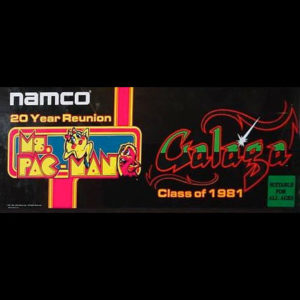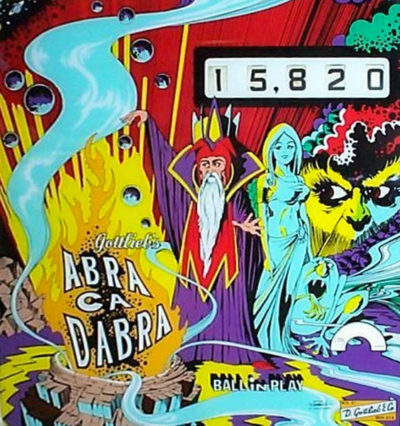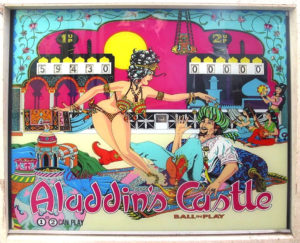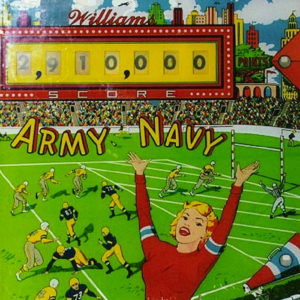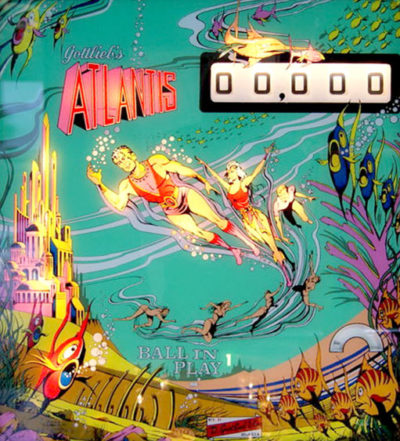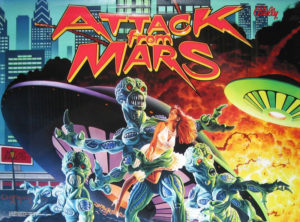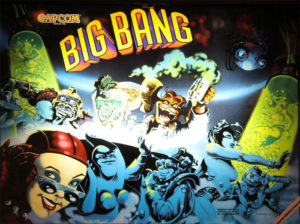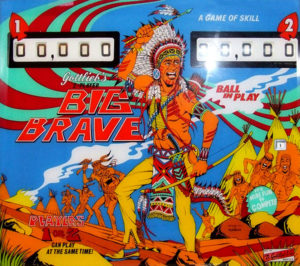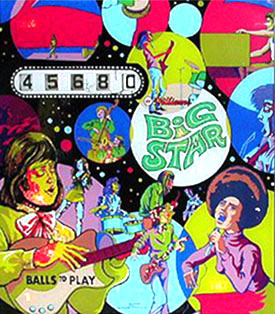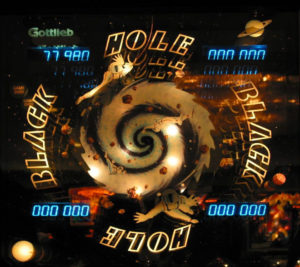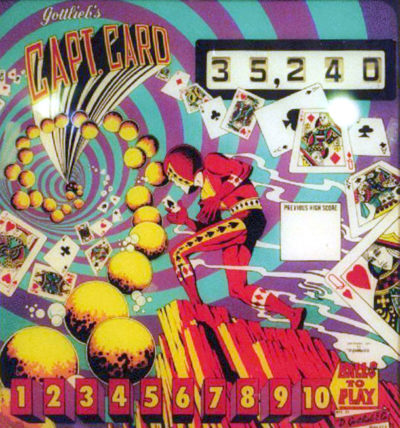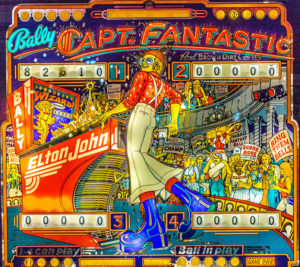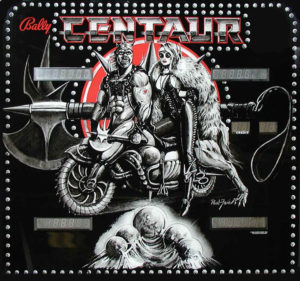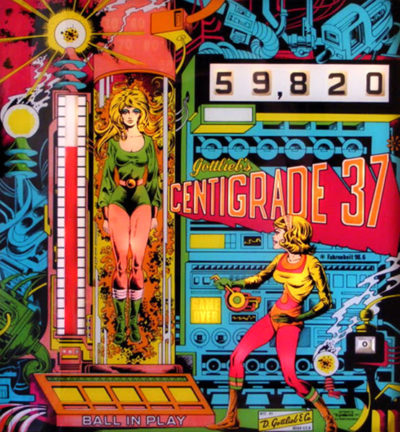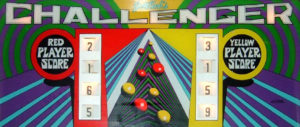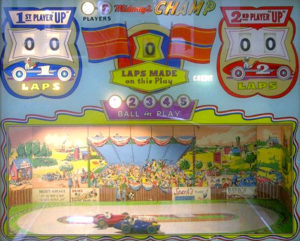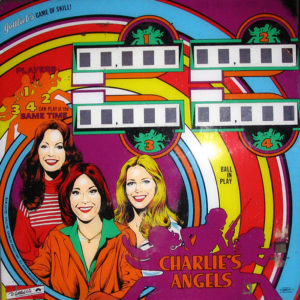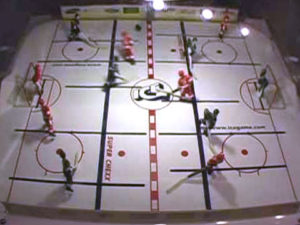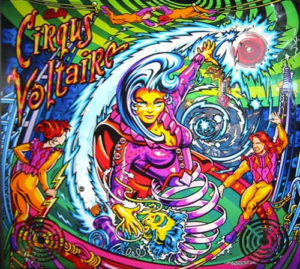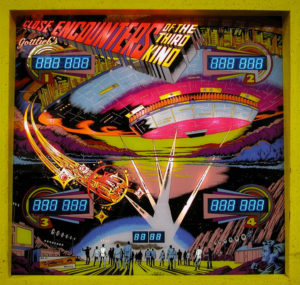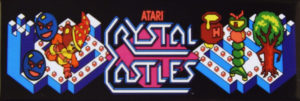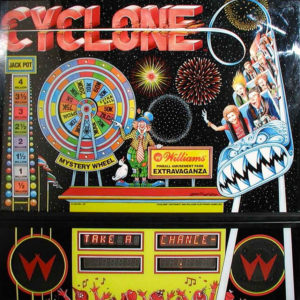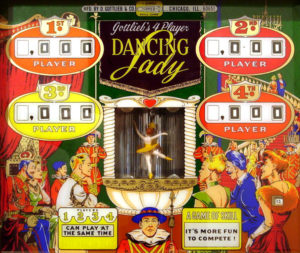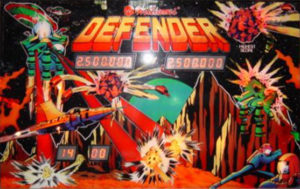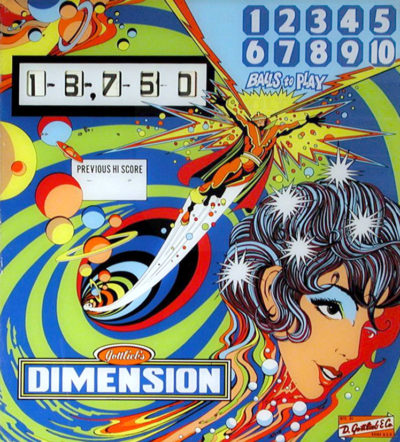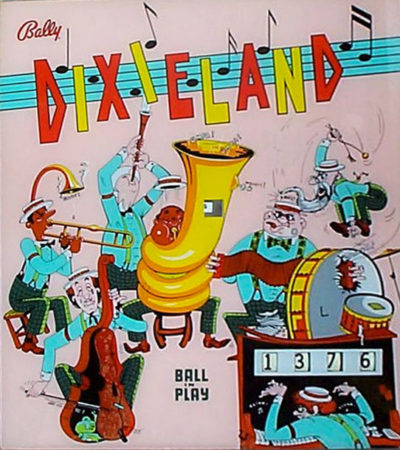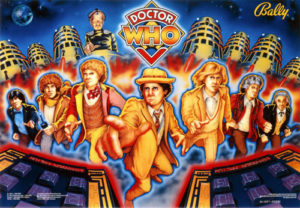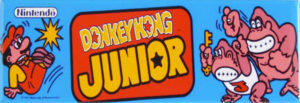-
June marked the month when Bally let Greg Kmiec and Christian Marche unveil their newest creation to the pinball world. This two-player game awards an extra ball when the A-B-C-D sequence is completed. C and D when completed, award the double bonus. The third flipper in the middle right of the playfield gives the player maximum control to shoot for the Aladdin’s Alley. Hitting the rollover at the top of this shot scores the lit value and then advances the value for the next completed shot. If you’re skillful enough to make it to the 5,000 shot, the next shot scores a special. This special remains lit for the balance of the ball in play. All in all, a typical Bally game of the era. This game was released at the same time as the classic Captain Fantastic Bally machine (that game is in the museum). Captain Fantastic made Bally #1.Yet another legendary, genre-defining game – in an era replete with genre-defining classics - in which a single player takes control of a ship trapped in the middle of an asteroid field. A number of large, slow-moving asteroids drift randomly around the play area and must be shot by the player. When shot, the asteroids will break into a number of smaller pieces, which must also be shot until, eventually, all of the asteroids and fragments will be destroyed and the next wave begins. Asteroids introduced real-world physics to video games for the first time, with speed and inertia all adding to the player’s problems. As well as the inertia of the player’s ship – forcing the player to allow for the ship slowing down and speeding up whenever the thrust button was utilized – shot asteroids would often send fragments flying in seemingly random directions, and at varying and unpredictable speeds. As well as the ever-present asteroids, alien saucers also make a regular appearance. These move diagonally around the screen, firing at the player’s ship and must be quickly destroyed.This game by Gottlieb is a very challenging design. It was invented by Ed Krynski and artwork was drawn by Gordon Morrison. This game has 10 drop targets lined up the left side of the playfield. If one target is hit, one scores 500 points. If, however, you’re skillful enough to hit a blue and white target at the same time, 5,000 points are awarded. Completing the sequence 1-9 lights the special at the bottom left rollover as well as lights the drop targets to score a special if all the targets are dropped. The player had to be wary when trying to freeze the ball on the right flipper, as one could lose the ball up the right guide rail (which has an opening in it the size of a ball). This playfield design was used a few times by Gottlieb, as it was a successful design (games like Gottlieb 300, for example, a bowling themed game). Scoring games by core were another option.This four-player machine is almost always considered to be in the top five best solid-state games of its genre. Brian Eddy designed this machine with art by Doug Watson. 3,450 examples of it were made. This fast-paced game is not based on the “Mars Attacks” movie but ironically came out the same time as the movie’s release. A sequel to this game is also in the museum by the name “Revenge From Mars.” The main theme of this amusing game is to complete the five attack waves activated by hitting the three drop targets in front of the saucer. Doing so drops the targets and allows shots to the saucer. After so many saucer hits, the saucer explodes into a flurry of strobe lights (first time used on a pinball machine) and sounds. If you make it to Mars Attacks, the game goes into hyper mode with a flurry of options and actions. Total annihilation of Mars is the ultimate goal. Many more feats and multi-balls are also present.Big Brave is a two-player electromechanical machine. 3,450 units were produced. Ed Krynski designed the machine and Gordon Morison was in charge of the artwork. This game was a typical Gottlieb game of the era. It has drop targets, resetting targets, bonus feature, double bonus option, and a special. Making the B I G rollover lights the pop bumpers. Hitting all five drop targets awards 5,000 points. Hitting the last drop target left when the B I G is hit awards a special. The vari-target, as it was called, was an exclusive Gottlieb design. As you hit the target – depending how hard you hit it – would result in bigger point values. It will then reset to be hit again and again. A four-player version of this game, Big Indian, was also produced.This one-player September release was designed by Steve Kordek with art package laid out by Christian Marche. 1,130 units were made, which is a pretty low production run. This is an add-a-ball game with a replay version also released called “Superstar.” This machine incorporates not one but three pop-up posts to deflect the ball from draining through the side drains as well as the flipper drain. The object of the machine is to extend your playing time by winning more free balls. This is achieved by completing the s-u-p-e-r roll-overs at the top of the play field. Doing so lights the hidden center kick-out hole. By dropping the target in front of this hole, one has a shot at the extra ball prize. If both specials are lit, two free balls are awarded. Completing each five-star sequence also advances the center shot award. Score is another to earn extra balls per game. Replay games were much more popular back in this era, but not every locale allowed replays.This game is another breakthru game by Williams. 13,075 units were made. Steve Ritchie designed the game and Tony Ramunni did the art package. Larry Demar programmed the game. Black Knight invented the “magna save” feature which is activated by the second flipper buttons on the side of the cabinet. When active, timing is critical. By activating this feature, the ball, which was about to drain down the side drains, is magically transported to the ball guide lane back to the flipper for continued play. This game also incorporated the “bonus ball” feature if more than one player was playing the game. The person with the highest score is awarded at the end of the game with a bonus round, which is timed to try and pop a game. Finally, this game is the first game to have a two-level playfield. Steve Ritchie, the designer, used his voice as the Black Knight.Another rare machine stands before you. Although 2,885 units were produced, they were all sent to France as a promotion in a contest to market Canada Dry soda. Designed by Ed Krynski and art by Gordon Morrison, this game was released in the US as a one player, two player and four player version. If you like drop targets this is your game. Fifteen drop targets live in this playfield design! If you’re skillful enough to hit all the upper drop targets, the side extra ball rollovers activate. The same is true if you hit the bottom five drop targets. If, however, you’re skillful enough to complete all fifteen targets, the specials are activated. Score is another way to win. The machines put on location in France provided high-scoring winners with monetary prizes from Canada Dry. I wish they would do this in the united States, especially in Atlantic City.May was the release month for this game. Designer Ed Krynski and artist Gordon Morison put together the package. Production run was low, at 675 units. This is an add-a-ball game variant, the replay version was called High Hand. The challenging part of this playfield design is trying to lock a ball in the eject hole for extra balls. Four batteries of drop targets in four colors are along the sides of the playfield. Making a completion of a color of drop targets increases the value of the eject and side drains. If all the drop targets are completed, the extra ball features light up. Score is another way to win balls set by the operator. No match units were incorporated into these games as, again, that was considered a form of gambling, i.e. winning a free game.This game is considered to be the #3 game of the ’70s. It was released in June, designed by Greg Kmiec and art by Dave Christiansen. It had a production run of 16,200 units, a record to that date for production by Bally. The game has a rock star tie in the form of Elton John, who was at his peak back then. The movie “Tommy” was also an influence for the game’s graphics. The triple flipper arrangement of the game made for fast action on the playfield. A bonus feature is present, a 5-bank drop target that when hit, advances through extra ball and then special. A free ball gate, when activated, extends the ball’s life. This game is one of the last most collectible electromechanical-era games produced. It was the complementary game to Bally’s Wizard pinball which, again, found its theme based on the “Tommy” movie by The Who. Celebrity tie-ins were found to be big sellers.This beautiful piece of art was designed by Jim Patla with artwork by Paul Faris. 3,700 units were designed and a reprise run of 1,550 games were made in 1983 due to its popularity. The first thing one notices when walking up to this game is the color theme and the vibrant lighting. Pressing either flipper button when the game is in attract mode gives you an instructional light show on its features; the orb feature is the most exciting. Spelling out orbs by completing the drop target sequence stores another potential ball into play if the release orbs target is hit. This target has a magnet under it which holds the ball in position when the orbs are ejected. The balls are ejected from under the playfield through a baseball machine pitcher-like mechanism mounted upside down in the shooter lane. This mechanism was inspired by a Bally ‘50s game called Balls A Poppin. The captive ball drop target sequence is another tough goal to accomplish.This game scores as the #10 most desirable game of the ’70s. It came out in August, designed by Ed Krynski and Allen Edwell with artwork by Gordon Morrison. Backbox animation is included in the game. A giant thermometer advances when drop targets are hit and by rolling over the rollovers. If the thermometer is advanced to the top, the special lights on the eject hole. A, B, C and D rollovers, if hit, advances the thermometer 5 advances. If a player completes all the letters, he gets 5,000 points in the eject hole. A double bonus feature is present also. All in all, a very fast-paced game. Artists, as a general rule, didn’t help design playfields. They were given the game mechanically more or less completed and had to invent the graphics and theme on their own.Centipede is a vertically oriented shoot ‘em up arcade game produced by Atari, Inc. in 1981. The game was designed by Ed Logg along with Dona Bailey, one of the few female game programmers in the industry at this time. It was also one of the first arcade coin-operated games to have a significant female player base, after Pac-Man. The player defends against centipedes, spiders, scorpions and fleas, completing a round after eliminating the centipede that winds down the playing field. The player is represented by a small, “somewhat humanoid head” at the bottom of the screen. The player moves the character about the bottom area of the screen with a trackball and fires laser shots at a centipede advancing from the top of the screen down through a field of mushrooms. Shooting any section of the centipede creates a mushroom; shooting one of the middle segments splits the centipede into two pieces at that point. Each piece then continues independently on its way down the board, with the first section of the rear piece becoming a new head. If the head is destroyed, the section behind it becomes the next head. The centipede starts at the top of the screen, traveling either left or right. When it hits a mushroom or the edge of the screen, it drops one level and switches direction. Thus, more mushrooms on the screen cause the centipede to descend more rapidly. The player can destroy mushrooms by shooting them, but each takes four hits to destroy. If the centipede reaches the bottom of the screen, it moves back and forth within the player area and one-segment “head” centipedes are periodically added. This continues until the player has eliminated both the original centipede and all heads. When all the centipede’s segments are destroyed, a new centipede forms at the top of the screen. Every time a centipede is eliminated, however, the next one is one segment shorter and is accompanied by one additional, fast-moving “head” centipede. A player loses a life when hit by a centipede or another enemy, such as a spider or a flea. The flea leaves mushrooms behind when fewer than five are in the player area, though the number required increases with level of difficulty. Spiders move across the player area in a zig-zag fashion and occasionally eat some of the mushrooms. Scorpions poison every mushroom they touch, but these never appear in the player’s movement region. A centipede touching a poisoned mushroom hurtles straight toward the player’s area. Upon reaching the player’s area, the centipede returns to normal behavior.Here is one you do not see every day. This is a Gottlieb Challenger from 1971. Only 110 of these were produced back in the day. How many are still around now … head-to-head pinball game with two players at opposite ends of the playfield, simultaneous soccer like play, can not be played with one player. Each player has flipper buttons which control only those flippers facing the opponent. Ball enters play from between the flippers. Game has 8 flippers and vertically mounted score reels. The playfield actually tilts towards and away from the players, depending on which end served the ball.Super Chexx is a table hockey arcade game manufactured by Innovative Concepts in Entertainment (ICE).[1] ICE began manufacturing these in 1982 and continues production to this day in Clarence, New York just outside of Buffalo. These types of games are also known as bubble hockey, rod hockey, table hockey or dome hockey because of the long rods used to control the players and the distinctive dome or “bubble” covering the playing field. The game can be played by two opposing players who control all five hockey players and the goalie for their side (singles) or as a two on two game (doubles). Players control their five skaters with long rods that move in and out to bring skaters up and down the ice and spin 360 degrees. A knob is used to move the goalie from side to side. Each player also a “boo button” to simulate sounds from the crowd. Vintage versions of Super Chexx feature the USA vs. Russia, Canada vs. Russia, or USA vs. Canada formats. In 2010 ICE introduced a Deluxe Home version of the game with no coin doors and started offering NHL and AHL licensed team versions. There is also a 30th Anniversary “Miracle on Ice” Edition of the game featuring the classic USA vs CCCP teams licensed through USA Hockey. Licensed games feature team colors and logos with custom hand-painted players in replica jerseys. The early versions of the game were made with blue bases, but most of the games are now made with red bases. The first black bases were made for a Bubble Boys Tournament with Wayne Gretzky and Bud Light in 1999. There was a limited edition of 100 games with black bases made in 2005. A further limited edition with the black base was made in 2007. The home version of the game has a base which can be split and hinged to fit through narrow doorways and comes in red or black.This game is one of the most colorful machines ever produced and it has a lot of toys to boot. 2704 of them were made and when they came out, demand was low so many sat around for years in their shipping boxes. Today it’s a top 10 collectible machine. John papadiuk designed the game with linda deal penning the artwork. Neon, disappearing pop bumper, managerie ball, magnetized ringmaster, cannon ball backglass animation and a dot matrix display embedded above the playfield are a few of its unique features. The object of the game is to complete all the playfield insert parts by defeating them. This spells out the word circus.. The ringmaster must also be completed. If you’re skillful enough to do this, you become part of the circus which brings you into 6 levels of multiball competition to complete the game. Good luck!!!September was the month for the introduction of this game. Both solid-state and mechanical versions were produced (9,950 versus 550 units, respectively). Ed Krynski designed the machine with art by Gordon Morison. A roto-target was incorporated into the upper right of the game, a Gottlieb exclusive. Hitting the A-B-C rollovers lights up the extra ball target and increases the value of the roto-targets as well as the drop target values. Knocking down all the drop targets increases the bonus multiplier value. The second time this feat is completed lights the special roto-target value. This game also features a bonus advance bank which increases to 20,000 points and a two to five times bonus multiplier feature. Score is the other way to win games.Crystal Castles has nine levels with four castles each, and a tenth level which features a single castle — the clearing of which ends the game. Each of the 37 trimetric-projected castles consists of a maze of hallways filled with gems and bonus objects, and also includes stairs, elevators and tunnels that the player can use as shortcuts. The three-letter initials of the player with the highest score are used to form the first level’s castle structure. When all gems in a castle have been collected, the player moves on to the next castle. The player can also skip some castles and acquire additional lives and points by using secret warps activated by making Bentley Bear jump at special locations. A trackball and “jump” button are used for controlling Bentley Bear’s motions. Gems are collected by simply walking over them, and a bonus is given upon collection of the last gem. While collecting gems, there are a number of enemies that try to stop Bentley and/or collect the gems for themselves. With two exceptions, if touched by the enemies he will lose one of his lives. Any gems collected by the enemies also result in a lower obtainable score for that screen. Likewise, if the last available gem is collected by the enemy, the player also loses the last gem bonus. Enemies can be avoided by use of the maze and its constructs, or by making Bentley jump over opponents with the jump button, in some cases also allowing him to stun them. Some types of enemies will track Bentley’s movements in certain ways, while others move at random. If Bentley is touched, he “cries out” in a distinctive manner with the use of a cartoonish word balloons. If 3 or more lives remain, he says “BYE!”; if 2 lives still remain, the quotation is “OH NO!”; if 1 life is left, it is “OUCH!”; and finally, for the last lost life (which ends the game), he says “#?!”, so as to imitate an obscenity. At the beginning of every maze, gems are worth 1 point each; this value increases by 1 for every gem Bentley picks up, to a maximum of 99. Each maze also randomly includes a hat or honey pot, which serve the dual purpose of awarding points and providing Bentley with the ability to defeat specific enemies. The hat is worth 500 points and will make Bentley invulnerable for a few seconds and allow him to eliminate Berthilda the witch, who appears in the last maze of each level. The honey pot is worth 1,000 points, and picking it up can delay the landing of a swarm of bees. Other villains present in the game include: “Nasty Trees” which become more ornery as levels progress, a ghost that will usually appear in the Hidden Spiral levels, dancing skeletons, “Gem Eaters” who Bentley Bear can defeat if he catches them while eating a gem, and also the devilish “Crystal Balls” creatures that in later levels tend to follow Bentley Bear persistently as he collects gems. The Nasty Trees and Crystal Balls can also pick up gems. Crystal Castles contains two notable easter eggs. Jumping 100 times or more in the southeast corner of level 1?1 and clearing the maze of all gems will make ATARI appear on level 1?2.[2] On level 5?4, if the player kills Berthilda and goes to the corner of the area where she was and jumps, “FXL” will appear in the southeast corner of the screen. These are the initials for Franz X. Lanzinger, a designer of Crystal Castles.This machine is one in a trilogy that Williams produced with an amusement park theme. 9,400 were made with design accolades going to Barry Oursler and art by Python Anghelo. Ronald and Nancy Reagan appear on the backglass. The Comet and Cyclone are two roller coasters from the Coney Island era. If you ride the Comet ramp six times, a million-point shot is possible. The Cyclone ramp in the upper right awards the accumulated jackpot on the backglass if hit three times. Hitting the spook house drop target exposes a gobble hole which spins the backglass wheel for a point award or extra ball. A ferris wheel bonus a shooting gallery bonus and a bonus multiplier shot in the lower left complete this impressive package. “You pay your money, you take your chances” in this classic machine.This four-player machine was produced in November of the year with 2,675 units fabricated. It was designed by Ed Krynski with art penned by Art Stenholm. Technically, a couple of firsts were incorporated into this machine for Gottlieb, like an automatic ball lifter, decagon score reels and carousel roto-targets. The carousel roto-target allow one to shoot at one or two targets at a time if flipper savvy. The star on the unit awards an extra ball. The object of the game is to achieve high-enough scores to award replays. The big points are awarded when the two 10x lights under a roto-target light up, awarding 100 times the value of the number hit. The most attractive gadget built into the game is the dancing ballerina in the backglass, which dances when certain elements of the play field are achieved. A highly collectible game in its own right.Defender is an arcade video game developed and released by Williams Electronics in 1980. A shooting game featuring two-dimensional (2D) graphics, the game is set on a fictional planet where the player must defeat waves of invading aliens while protecting astronauts. Development was led by Eugene Jarvis, a pinball programmer at Williams; Defender was Jarvis’ first video game project, and drew inspiration from Space Invaders and Asteroids. Defender is a two-dimensional side-scrolling shooting game set on the surface of an unnamed planet. The player controls a space ship as it navigates the terrain, flying either to the left or right. A joystick controls the ship’s elevation, and five buttons control its horizontal direction and weapons. The object is to destroy alien invaders, while protecting astronauts on the landscape from abduction. Humans that are successfully abducted return as mutants that attack the ship. Defeating the aliens allows the player to progress to the next level. Failing to protect the astronauts, however, causes the planet to explode and the level to become populated with mutants. Surviving the waves of mutants results in the restoration of the planet. Players are allotted three chances (lives) to progress through the game and are able to earn more by reaching certain scoring benchmarks. A life is lost if the ship comes into contact with an enemy or its projectiles. After exhausting all lives, the game ends. Defender is an arcade video game developed and released by Williams Electronics in 1980. A shooting game featuring two-dimensional (2D) graphics, the game is set on a fictional planet where the player must defeat waves of invading aliens while protecting astronauts. Development was led by Eugene Jarvis, a pinball programmer at Williams; Defender was Jarvis’ first video game project and drew inspiration from Space Invaders and Asteroids. Defender was one of the most important titles of the Golden Age of Arcade Games, selling over 55,000 units to become the company’s best selling game and one of the highest-grossing arcade games ever. Praise among critics focused on the game’s audio-visuals and gameplay. It is frequently listed as one of Jarvis’ best contributions to the video game industry as well as one of the most difficult video games. Defender was ported to numerous platforms, inspired the development of other games, and was followed by sequels and many imitations. Defender is a two-dimensional side-scrolling shooting game set on the surface of an unnamed planet. The player controls a space ship as it navigates the terrain, flying either to the left or right. A joystick controls the ship’s elevation, and five buttons control its horizontal direction and weapons. The object is to destroy alien invaders while protecting astronauts on the landscape from abduction. Humans who are successfully abducted return as mutants that attack the ship. Defeating the aliens allows the player to progress to the next level. Failing to protect the astronauts, however, causes the planet to explode and the level to become populated with mutants. Surviving the waves of mutants results in the restoration of the planet. Players are allotted three chances (lives) to progress through the game and are able to earn more by reaching certain scoring benchmarks. A life is lost if the ship comes into contact with an enemy or its projectiles. After exhausting all lives, the game end.Demolition Man is a Williams pinball machine released in February 1994. It is based on the motion picture of the same name. It is part of WMS’ SuperPin line of widebody games. Sylvester Stallone (John Spartan) and Wesley Snipes (Simon Phoenix) provided custom speech for this game during ADR sessions at Warner Brothers Studios in Los Angeles under the direction of Jon Hey. Hey scored the music of the pinball game in part based upon the movie score by Academy Award winner Elliot Goldenthal, but including new music. Multiball modes This game is centered on multiball modes. The player has to shoot the left ramp when the “freeze” light is lit (lit by the right inlane) to “lock” a ball. When the required amount of locks are made, the player has to shoot the left loop to start multiball. Fortress Multiball (2 balls required) – A normal multiball mode with 3 jackpots and the “Super Jackpot”. 1-4 balls can be shot up. Museum Multiball (3 balls required) – Jackpots everywhere, except the standups. After the “Super Jackpot” the Multiball starts over. 3-6 balls can be shot up. Wasteland Multiball (4 balls required) – Same as “Fortress Multiball”. If not getting the lighting jackpots, the next jackpot will appear and the previous jackpot will stay. 4-8 balls can be shot up. Cryoprison Multiball (5 balls required) – The “Super Jackpot” is lit, from the beginning of the multiball. After getting the “Super Jackpot” it will lit again after hitting an arrow or more. Completing all four multiball modes lights the right ramp for the wizard award, Demolition Jackpot, which is the total amount of all the jackpots collected during the game. The Demolition Jackpot is lost if the ball drains. If you hit all jackpots in a multiball, the “Super Jackpot” light will lit. Getting the ball up to the “Cryo-Claw” whilst, you will get it. The “Super Jackpot” light turns off, if all the balls drain and the Multiball is over, the “Super Jackpot” is lost.This game was an “add-a-ball” game; the replay version was called 2001. Production run was 490 units. This was the first game to feature the in-line drop targets in a bank of targets. It was designed by Ed Krynski with art by Gordon Morison. A total of 20 drop targets divided into 5 targets per color. Knocking down a full left set of targets or a right set of targets awarded extra balls to be played during your current game (versus free games as the replay version awarded). The targets would reset after each ball. Extra balls were also awarded if certain scores were achieved as set by the operator. Previous high scores could be posted by the arcade on the backglass as a contest to try and beat the high score. This game was near the end of single-player Gottieb games with the smaller flippers. All in all, a classic game requiring accuracy in your shots to gain extra balls!There are 7 Doctors, as one can plainly see from the backglass… quite conveniently, they are numbered 1-7. Each Doctor has the effect of changing the rules of one area of the Playfield, making a list of the rules all the more annoying and probably confusing. First some general information about the Doctors… there are many ways to “spot” doctors throughout the game – one is awarded at the start of any ball, and can be spotted through the Transmat target or Video Mode. At the start of a ball (or when a ball has been locked), you get to choose the “current” doctor – his picture will flash on the backglass. When a doctor- spotting shot is made, the current doctor will become solidly lit (so his attributes are carried over for the rest of the game), and the “current” doctor becomes the previously unlit doctor directly to the left of the previous one. There are 2 ways to spot all seven doctors – either go through them all one-by-one, or shoot the Emperor Daleks jackpot. Either way, all of them will be lit for the rest of the game, and you receive an additional bonus of 2OM, as well as a small animation, which plays even after a tilt! After all 7 doctors are spotted, they can be spotted a second (third, etc) time, and running through all 7 a second time awards another 2OM bonus. Also, each doctor spotted in the game (this count may be more than 7) is worth a 1M bonus at the end of the last ball (so don’t tilt it!), and this bonus (unlike the regular bonus) is multiplied by the Playfield X.Donkey Kong is an arcade game released by Nintendo in 1981. It is an early example of the platform game genre, as the gameplay focuses on maneuvering the main character across a series of platforms while dodging and jumping over obstacles. In the game, Jumpman (since renamed Mario) must rescue a damsel in distress, Lady (now named Pauline), from a giant ape named Donkey Kong. The hero and ape later became two of Nintendo’s most popular characters. Donkey Kong is one of the earliest examples of the platform game genre; it is sometimes said to be the first platform game, although it was preceded by Space Panic. In contrast to Space Panic, however, Donkey Kong was the first platform game to feature jumping, introducing the need to jump between gaps and over obstacles or approaching enemies, setting the template for the platform genre. Competitive video gamers and referees stress the game’s high level of difficulty compared to other classic arcade games. Winning the game requires patience and the ability to accurately time Jumpman’s ascent. In addition to presenting the goal of saving the Lady, the game also gives the player a score. Points are awarded for finishing screens; leaping over obstacles; destroying objects with a hammer power-up; collecting items such as hats, parasols, and purses (apparently belonging to the Lady/Pauline); and completing other tasks. The player typically receives three lives with a bonus awarded for the first 7,000 points, although this can be modified via the game’s built in DIP switches. The game is divided into four different one-screen stages. Each represents 25 meters of the structure Donkey Kong has climbed, one stage being 25 meters higher than the previous. The final screen occurs at 100 m. Later ports of the game omit or change the sequence of the screens. The original arcade version includes: Screen 1 (25 m), Jumpman must scale a seven-story construction site made of crooked girders and ladders while jumping over or hammering barrels and oil barrels tossed by Donkey Kong. The hero must also avoid fireballs which generate when barrels run into the oil drum at the bottom of the site. Players routinely call this screen “Barrels”. Screen 2 (50 m), Jumpman must climb a five-story structure of conveyor belts, each of which transports cement pans. The fireballs also make another appearance. This screen is sometimes referred to as the “Factory” or “Pie Factory” due to the resemblance of the cement pans to pies. Screen 3 (75 m), Jumpman rides up and down elevators while avoiding fireballs and bouncing objects, presumably spring weights. The bouncing weights (the hero’s greatest danger in this screen) emerge on the top level and drop near the rightmost elevator. The screen’s common name is “Elevators”. This screen appears as an unlockable stage in Super Smash Bros. Brawl. Screen 4 (100 m), Jumpman must remove the eight rivets which support Donkey Kong. The fireballs remain the primary obstacle. Removing the final rivet causes Donkey Kong to fall and the hero to be reunited with Lady/Pauline. This is the final screen of each level. Players refer to this screen as “Rivets”. The player loses a life if: Jumpman collides with a barrel, fireball, flaming oil barrel, spring weight, cement pan, or Donkey Kong himself Jumpman falls off the structure or through open rivet holes The bonus timer reaches 0. These screens combine to form levels, which become progressively tougher. For example, Donkey Kong begins to hurl barrels faster and sometimes diagonally, and fireballs get speedier. The victory music alternates between levels 1 and 2. The 22nd level is unofficially known as the kill screen, due to an error in the game’s programming that kills Mario after a few seconds, effectively ending the game. With its four unique levels, Donkey Kong was the most complex arcade game at the time of its release, and only the second game to feature multiple levels (the first was Gorf by Midway Games).Donkey Kong Jr. is a 1982 arcade-style platform video game by Nintendo. It first appeared in arcades, and, over the course of the 1980s, was later released for a variety of platforms, most notably the Nintendo Entertainment System. The game’s title is written out as Donkey Kong Junior in the North American arcade version and various ports to non-Nintendo systems. Its eponymous star, Donkey Kong Jr., also called simply Junior[3] or abbreviated as DK Jr.,[4] is trying to rescue his father Donkey Kong, who has been imprisoned. Donkey Kong’s cage is guarded by Mario, in his only appearance as an antagonist in a video game. This game is the sequel to the video game Donkey Kong, which featured Mario as the hero and Junior’s father as the villain. Plot: Mario (known as Jumpman in Donkey Kong) has captured Donkey Kong and placed him in a cage as punishment for kidnapping his girlfriend Pauline.[5] Donkey Kong Jr. must rescue his father from Mario by working his way through a series of stages. Mario attempts to stop DK Jr. by releasing animals and putting obstacles in his way. When DK Jr. succeeds at the final level, Donkey Kong is freed and kicks Mario into the distance, leaving him to an unknown fate. Gameplay Like its predecessor, Donkey Kong, Jr. is an arcade-style platform game. There are a total of four stages, each with a unique theme. DK Jr. can run left and right, jump, and grab vines/chains/ropes to climb higher on the screen. He can slide down faster by holding only one vine, or climb faster by holding two. Enemies include “Snapjaws,” which resemble bear traps with eyes, bird-like creatures called “Nitpickers”, and “Sparks” that roam across the wiring in one of Mario’s hideouts. To pass the first three stages, DK Jr. must reach the key at the top. In the fourth stage, DK Jr. must push six keys into locks near the top of the stage to free Donkey Kong. After a brief cutscene, the player is taken back to the first stage at an increased difficulty. DK Jr. loses a life when he touches any enemy or projectile, falls too great a distance, or falls off the bottom of the screen. Additionally, he loses a life if the timer counts down to zero. The game ends when the player loses all of his or her lives.



